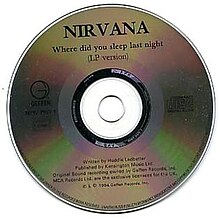In the Pines
| "In the Pines" | |
|---|---|
| Song | |
| Published | 1917 |
| Writer(s) | Traditional |
| "Where Did You Sleep Last Night" | ||||
|---|---|---|---|---|

"Where Did You Sleep Last Night" cover
|
||||
| Song by Nirvana from the album MTV Unplugged in New York | ||||
| Released | 1 November 1994 | |||
| Recorded | November 18, 1993 at Sony Music Studios in New York City | |||
| Length | 5.08 | |||
| Label | DGC Records | |||
| Writer(s) | Lead Belly | |||
| Producer(s) | Alex Coletti, Scott Litt, Nirvana | |||
| MTV Unplugged in New York track listing | ||||
|
|
||||
|
||||
| 13 tracks |
|---|
"In the Pines", also known as "Where Did You Sleep Last Night?" and "Black Girl", is a traditional American folk song which dates back to at least the 1870s, and is believed to be Southern Appalachian in origin. The identity of the song's author is unknown, but it has been recorded by many artists in numerous genres. Traditionally, it is most often associated with the American folk and blues musician Lead Belly, who recorded several versions in the 1940s, as well as the American bluegrass musician Bill Monroe, who helped popularize the song (in a different variant, featuring lyrics about a train) among bluegrass and country audiences with his versions recorded in the 1940s and 1950s.
The song, performed by The Four Pennies, reached the UK top twenty in 1964. A live rendering by the American grunge band Nirvana, which reinterpreted Lead Belly's version and was recorded during their MTV Unplugged performance in 1993, helped introduce the song to a new generation.
Like numerous other folk songs, "In the Pines" was passed on from one generation and locale to the next by word of mouth. The first printed version of the song, compiled by Cecil Sharp, appeared in 1917, and comprised just four lines and a melody. The lines are:
Black girl, black girl, don't lie to me
Where did you stay last night?
I stayed in the pines where the sun never shines
And shivered when the cold wind blows
In 1925, a version of the song was recorded onto phonograph cylinder by a folk collector. This was the first documentation of "The Longest Train" variant of the song, which includes a verse about "The longest train I ever saw". This verse probably began as a separate song that later merged into "In the Pines". Lyrics in some versions about "Joe Brown's coal mine" and "the Georgia line" may refer to Joseph E. Brown, a former Governor of Georgia, who famously leased convicts to operate coal mines in the 1870s. While early renditions which mention the head in the "driver's wheel" make clear that the decapitation was caused by the train, some later versions would omit the reference to the train and reattribute the cause. As music historian Norm Cohen pointed out in his 1981 book, Long Steel Rail: The Railroad in American Folksong, the song came to consist of three frequent elements: a chorus about "in the pines", a verse about "the longest train" and a verse about a decapitation, but not all elements are present in all versions.
...
Wikipedia
